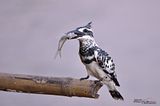January 8th saw me trying to find a flock of Japanese Waxwings in Kaku without luck. So I continued walking from Kaku to Onozuru in hope of getting some interesting species. I walked and walked until I reached the area of Taromaru (太郎丸). My eyes caught a sight of a lush green curve of the Oita River bordered by dark tall trees in the distant. One moment I thought that it looked an ideal place for the exotic Mandarin Ducks. Then I was a bit shocked to see that there was actually a flock of approximately 100 Mandarin Ducks (Aix galericulata) swimming in the river along with other species of ducks like Mallards and Common Teals. That lush green curve of Oita River seemed like a real heaven to me!





Mandarin Ducks (Aix galericulata)



My first sight of a flock of wild Mandarin Ducks



The Mandarin Duck is probably one of the most well known ducks in the world. We often see them in parks and captivities, but nothing compares to the sight of them in the wild. I have seen them several times back in Thailand, where the species is a rare vagrant to the northern wetlands. I once saw it in Beppu as well. A female once flew across the Spa Beach next to my dorm. However, according to Furuso san, they can also be found at Sekino-E as well. But these former sightings do not compare to the sight of a large flock swimming happily in the midst of the green water surrounded by thick forest. The males were constantly displaying towards the females in groups. Their weird calls filled the sound of the area. A Northern Goshawk and 2 Eurasian Sparrowhawks also came perching on the tree nearby. I thought I would get some action shots but all of them just flew out too soon. I didn't know why. Too bad I couldn't find a way to get any closer to the ducks as the area was very limited. Guess I just have to go back again and figure out how to get a better position.
























































.jpg)
